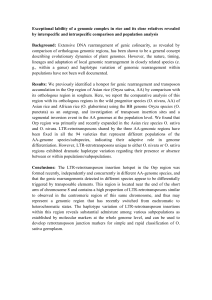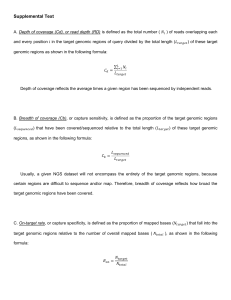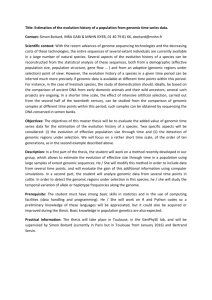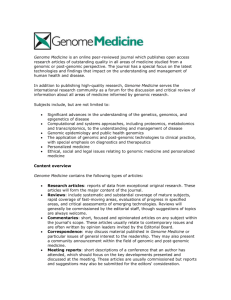Microsoft Word
advertisement
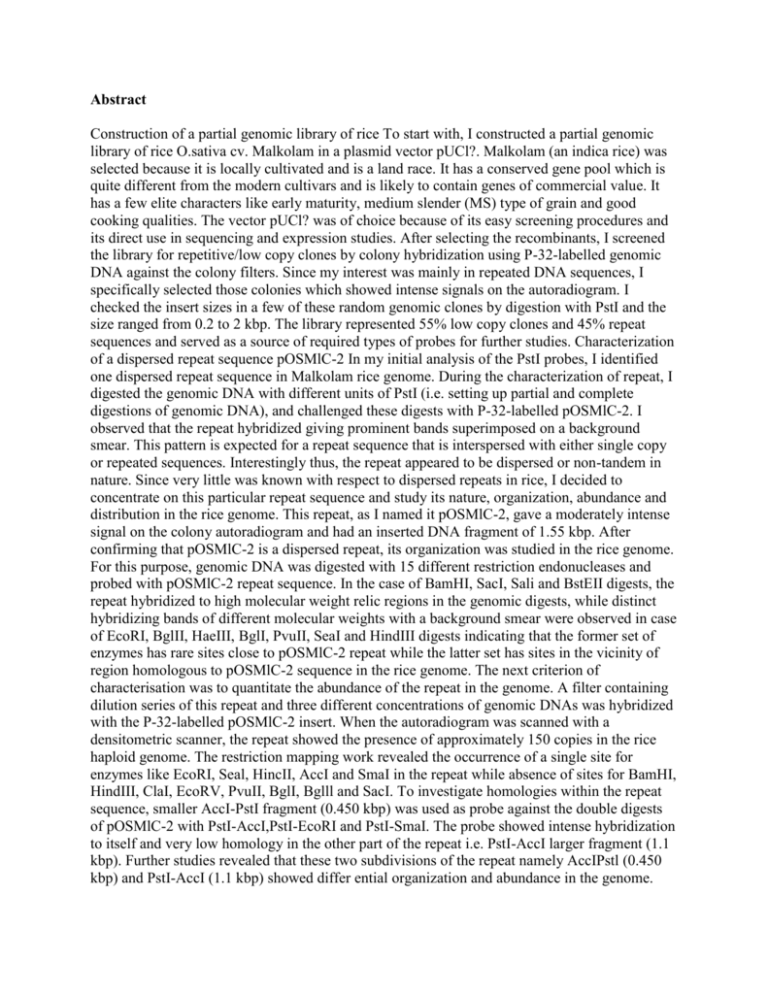
Abstract Construction of a partial genomic library of rice To start with, I constructed a partial genomic library of rice O.sativa cv. Malkolam in a plasmid vector pUCl?. Malkolam (an indica rice) was selected because it is locally cultivated and is a land race. It has a conserved gene pool which is quite different from the modern cultivars and is likely to contain genes of commercial value. It has a few elite characters like early maturity, medium slender (MS) type of grain and good cooking qualities. The vector pUCl? was of choice because of its easy screening procedures and its direct use in sequencing and expression studies. After selecting the recombinants, I screened the library for repetitive/low copy clones by colony hybridization using P-32-labelled genomic DNA against the colony filters. Since my interest was mainly in repeated DNA sequences, I specifically selected those colonies which showed intense signals on the autoradiogram. I checked the insert sizes in a few of these random genomic clones by digestion with PstI and the size ranged from 0.2 to 2 kbp. The library represented 55% low copy clones and 45% repeat sequences and served as a source of required types of probes for further studies. Characterization of a dispersed repeat sequence pOSMlC-2 In my initial analysis of the PstI probes, I identified one dispersed repeat sequence in Malkolam rice genome. During the characterization of repeat, I digested the genomic DNA with different units of PstI (i.e. setting up partial and complete digestions of genomic DNA), and challenged these digests with P-32-labelled pOSMlC-2. I observed that the repeat hybridized giving prominent bands superimposed on a background smear. This pattern is expected for a repeat sequence that is interspersed with either single copy or repeated sequences. Interestingly thus, the repeat appeared to be dispersed or non-tandem in nature. Since very little was known with respect to dispersed repeats in rice, I decided to concentrate on this particular repeat sequence and study its nature, organization, abundance and distribution in the rice genome. This repeat, as I named it pOSMlC-2, gave a moderately intense signal on the colony autoradiogram and had an inserted DNA fragment of 1.55 kbp. After confirming that pOSMlC-2 is a dispersed repeat, its organization was studied in the rice genome. For this purpose, genomic DNA was digested with 15 different restriction endonucleases and probed with pOSMlC-2 repeat sequence. In the case of BamHI, SacI, Sali and BstEII digests, the repeat hybridized to high molecular weight relic regions in the genomic digests, while distinct hybridizing bands of different molecular weights with a background smear were observed in case of EcoRI, BglII, HaeIII, BglI, PvuII, SeaI and HindIII digests indicating that the former set of enzymes has rare sites close to pOSMlC-2 repeat while the latter set has sites in the vicinity of region homologous to pOSMlC-2 sequence in the rice genome. The next criterion of characterisation was to quantitate the abundance of the repeat in the genome. A filter containing dilution series of this repeat and three different concentrations of genomic DNAs was hybridized with the P-32-labelled pOSMlC-2 insert. When the autoradiogram was scanned with a densitometric scanner, the repeat showed the presence of approximately 150 copies in the rice haploid genome. The restriction mapping work revealed the occurrence of a single site for enzymes like EcoRI, Seal, HincII, AccI and SmaI in the repeat while absence of sites for BamHI, HindIII, ClaI, EcoRV, PvuII, BglI, Bglll and SacI. To investigate homologies within the repeat sequence, smaller AccI-PstI fragment (0.450 kbp) was used as probe against the double digests of pOSMlC-2 with PstI-AccI,PstI-EcoRI and PstI-SmaI. The probe showed intense hybridization to itself and very low homology in the other part of the repeat i.e. PstI-AccI larger fragment (1.1 kbp). Further studies revealed that these two subdivisions of the repeat namely AccIPstl (0.450 kbp) and PstI-AccI (1.1 kbp) showed differ ential organization and abundance in the genome. Assessment of genomic variability among 18 cultivars of rice using the dispersed repeat sequence pOSMlC-2 The main aim of this study was to explore the potential role of pOSMlC-2 as a RFLP marker for distinguishing rice cultivars. It is now well known that RFLP technology has opened a door to detect and measure genetic variation in plants, in a manner not previously possible. Genomic DNAs from 19 elite cultivars were digested with 6 restriction enzymes namely EcoRI, EcoRV, OraI, SeaI, XbaI and HindIII and probed with P-32-labelled pOSMlC-2 insert. The probe was informative in revealing polymorphism with three enzymes namely EcoRV, OraI, and SeaI and deciphered different number of alleles with each enzyme. The similarity indices between the cultivars were calculated according to Nei's F statistic using computer software developed in our laboratory, A dendrogram was then constructed by the same software using the unweighted pair group method with arithmetic mean (UPGMA) for the variability analysis. For the construction of the dendrogram, polymorphic probe-enzyme combinations of only 18 cultivars were selected. One cultivar namely Pusa-33 was excluded all the time since the auto radiography picture with this cultivar was inconclusive. From the dendrogram, it was possible to group the cultivars into two major clusters, with smaller subclusters within them. Interestingly enough, this grouping agreed with the pedigrees of these cultivars. These interrelationships deciphered amongst closely related Indica cultivars will prove useful in the planning of future rice breeding programs in Maharashtra state and India.



